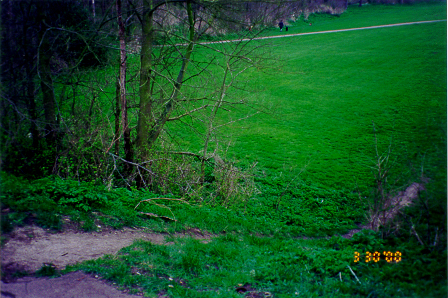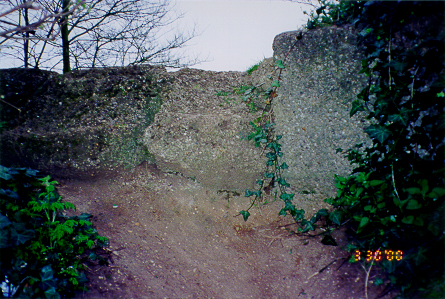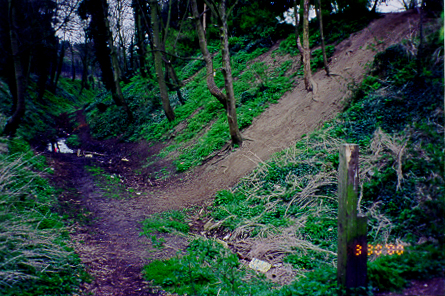
|
 |
Alexander "Sasha" Volokh
My tour of the Middle Ages, part II
Wallingford, England, March 29, 2000

Above: The park enclosed on two sides by the Wallingford town defences, seen from the top of
the wall
"After Alfred [the Great]'s defeat of the Danes at Edington in 878... he set about strengthening the
defences of Wessex in order to resist further Danish attacks.
He introduced a seaborne force to counter the Danes before they landed, and thereby earned for
himself the title of 'Father of the English Navy.'
The army was reorganized in such a way that troops were always available to meet an invasion, and he
also established a chain of fortified 'burghs' or towns in the kingdom, of which Wallingford and
Wareham are examples.
"A remarkable document recording Alfred's defensive strategy has survived.
It is now known as the 'Burghal Hidage,' and the towns or burghs mentioned in it are generally called
the 'forts of the Burghal Hidage.'
The basic idea was that a chain of strongpoints would be established round the borders of Wessex
together witih some in the central areas.
No subject was further than 25 miles (40 km) from a 'Hidage' fort, and many were closer; the forts
would serve as refuges in case of Danish attack.
From the borders of Kent and Sussex in the east to the fort at Lydford in Devon, the Burghal Hidage
provides a blueprint of Alfred's defensive strategy."
- Nigel and Mary Kerr, A Guide to Anglo-Saxon Sites (1982), pp. 172-74 (the rest of the quotes
here are from the same source)
 Above: An old rock in the Wallingford wall
Above: An old rock in the Wallingford wall
"But the system was more complex than this.
Apart from listing the forts, the Burghal Hidage also states how many 'hides' -- which were
traditionally the units of land which would support one free family and its dependants -- belonged to
each burgh.
Each hide was expected to contribute one man for the defence of the burgh to which it was allocated.
The defences of each burgh were then laid out in such a way that four men could guard every 5.5 yards
(5 metres) of wall.
So this was a remarkable system indeed -- a home defence plan which ensured that an adequate garrison
would be available to man each strongpoint in the event of a Viking attack, and the reasonable
probability of safety for every man and his family.
In this careful plan, which was unsurpassed elsewhere in Anglo-Saxon England, we perceive the cool
logic of Alfred, who sought not only to strengthen the Church and to educate his subjects, but also
to protect them from the wrath of the Northmen more effectively than any other Anglo-Saxon monarch."

Above: The ditch on the other side of the Wallingford town defences
"Wallingford was set on a royal estate and commanded a bridgepoint of the River Thames.
It was therefore a strategic site, and the scale of its defensive works is second only to that at
Wareham.
Wallingford has 2,400 hides allocated to it in the Burghal Hidage, giving a force of the same number
of men who in turn could defend a circuit 3,300 yards in circumference.
This figure tallies closely with the total length of Wareham's defences including the river frontage.
It is possible that the eastern boundary actually crossed the river at one point, in order to guard
the bridge across the river.
The modern council boundary swings across the river and follows the line of a ditch which might mark
the old defence line.
"Excavations have shown that the great banks were originally faced with timber, and that they were
restored on several occasions; perhaps the last was during the reign of Ethelred when the old fort at
South Cadbury was added to the network of strongholds.
Little is known of the inhabitants of Anglo-Saxon Wallingford, but it must have been a thriving
place, acting as a market centre for the country round.
As you walk through the modern town, notice how many of the streets meet at right angles.
This grid-iron street plan almost certainly reflects another aspect of Alfred's careful planning!
"The attractive town of Wallingford is beside the River Thames 12 miles (19 km) south-east of
Oxford.
The Saxon defences can best be seen in the park on the south-west side of the town."

Above: Two Vikings scale the defensive walls in a daring raid.
Back to Greys Court
Advance to Dorchester
Return to places page
Return to home page
|